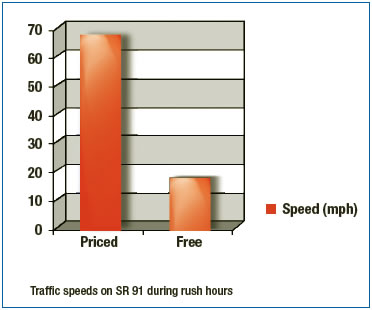III. BENEFITS OF CONGESTION PRICING
Congestion pricing benefits drivers and businesses by reducing delays and stress, by increasing the predictability of trip times, and by allowing for more deliveries per hour. It benefits mass transit by improving transit speeds and the reliability of transit service, increasing transit ridership, and lowering costs for transit providers. It benefits State and local governments by improving the quality of transportation services without tax increases or large capital expenditures, by providing additional revenues for funding transportation, by retaining businesses and expanding the tax base, and by shortening incident response times for emergency personnel and thus saving lives. By preventing the loss of vehicle throughput that results from a breakdown of traffic flow, pricing maximizes return on the public's investment in highway facilities. And it benefits society as a whole by reducing fuel consumption and vehicle emissions, by allowing more efficient land use decisions, by reducing housing market distortions, and by expanding opportunities for civic participation.
Benefits to Transit Riders and Carpoolers
Pricing in combination with transit services provides bus riders with travel time savings equivalent to those for drivers, and reduces waiting time for express bus riders due to more frequent service. Introduction of pricing in central London and Stockholm has resulted in significant shifts of commuters to transit, particularly buses. Bus delays in central London dropped by 50 percent after the pricing scheme was introduced. There was a 7 percent increase in bus riders. In Stockholm, 200 new buses were put into service in August 2005, several months in advance of the pricing trial, which began in January 2006. After the pricing scheme was implemented, daily public transportation use compared to the same month in 2005 was up by 40,000 riders daily. Ridership on inner-city bus routes rose 9 percent compared with a year earlier.
Within three months of the opening of the priced express lanes on California's SR-91, a 40 percent jump occurred in the number of vehicles with more than three passengers. Ridership on buses and a nearby rail line have remained steady. On San Diego's I-15 HOT lanes, revenues generated by toll-payers financed transit improvements that contributed to a 25 percent increase in bus ridership.
After the HOV lanes were converted into HOT lanes on I-15 in San Diego, carpooling increased significantly, even though there was no change in incentives to carpool - carpoolers continued to use the lanes free of charge, as they did before the lanes were converted. Similar effects were observed when the HOV lanes on I-25 in Denver were converted to HOT lanes in June 2006. It's not clear why carpooling increases - it could be a result of the extra publicity by the media.
Benefits to Drivers
On the State Route 91 priced lanes in Orange County, California, traffic during rush hours moves at over 60 mph, while the traffic in adjacent lanes crawls at average speeds of 15 mph or less. Commuters on the priced express lanes thus save as much as half an hour each way on the 10-mile trip, or as much as an hour a day.
If we could use pricing to restore free-flowing traffic conditions on other metropolitan freeways during rush hours, similar results could be achieved. An average commuter using a 5-mile freeway segment twice each day (i.e., once in each direction) would save about half an hour each day, or 120 hours annually - equal to three weeks of work or leisure time!
The day-to-day variation in travel times is now understood as a separate component of the public's and business sector's frustration with congestion. An important benefit of pricing is that it guarantees toll-paying vehicles a reliable trip speed and travel time.

Benefits to Businesses
Growing congestion and unreliability threatens truck transportation productivity and ultimately the ability of sellers to deliver products to market. Additionally, when deliveries cannot be relied on to arrive on time, businesses must keep extra "buffer stock" inventory on hand. This can be expensive. Pricing of the nation's major thoroughfares to guarantee free flow of traffic will ensure that reliability is restored to the transportation system, keeping business and transportation costs low. Lower costs will increase the competitiveness of U.S. businesses in international markets and boost the U.S. economy.